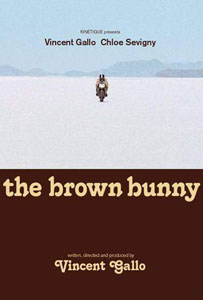
But it was the film's bleak, elegiac tone that left me with an ache I didn't shake for days. The Brown Bunny is as weirdly depressing as Buffalo '66 was weirdly funny, and once the hullaballoo about the infamous blowjob scene dies down, it will be seen as a stunningly private and beautiful work of art … albeit one most folks wouldn't want to sit through twice. Gallo stumps fans and critics alike by seeming to be a real jagoff in person, his unbridled ego so off-putting that even if you love his art, you'll have a tough time selling anyone on it. The Brown Bunny is even more divisive and polarizing than Buffalo '66, despite being far less confrontational and not at all subversive. The content frequently obscures the meaning, so people end up talking about the film in purely moral terms, or about its sensational backstory (Roger Ebert, in one of his few-ever genuine zingers, compared the movie unfavorably to his colonoscopy). And it's so utterly different in intent from Buffalo '66 that even Gallo's hardiest supporters will spend much of the movie looking for the "joke." The best approach is to simply encounter The Brown Bunny as you would a painting or sculpture, assigning no prejudice to it based on what you think you know about it or its creator, and certainly ignoring anything good or bad you might have heard about it. The bulk of the film traces Gallo, usually in long, lingering close-up, as he drives from New Jersey to Los Angeles, thinking. Extremely slow scenes in which virtually nothing happens of any apparent meaning are broken up by emotionally ambivalent roadside stops in which Gallo's character (Bud Clay) attempts instantaneous human connection only to abruptly reject it. Gradually, as the windshield wipers and stark soundtrack lull you into what feels like actual road-trip-trance, you become attuned to the state of intense pain you are observing. Gallo mixes extreme self-loathing with profound loss and hopelessness, but shows us only his seemingly blank surface, leaving the viewer to pick up on the submerged emotion only through the tiniest of clues. So what seems like a dispassionate exercise in simply making moviegoers fidget ultimately reveals itself to be a work of such emotional depth that you realize you're not fidgeting, you're trying to hide from it. It's the most accurate and unflinching portrait of grief I've ever seen captured on film. The staggering final sequence punctures the surface to reveal a raw and festering wound, and I'd argue that the extremity to which Gallo pushes it is entirely essential to the story, and it is what gives The Brown Bunny its lasting impact. Without the emotional release (as sloppy and ugly as real life), the film would come off as an induglent shaggy-dog joke, a la Cremaster 3. And while people will undoubtedly continue to focus on the hardcore-sex aspect, the metacontext of that is completely irrelevant. The Brown Bunny is neither important nor lamentable for the fierceness of its final scenes; as a piece of art, it required this kind of naked pain. You may not like it, but it had to be there. It's a brutal film in a lot of ways, not least because it makes you feel bad. But it makes you feel, and I admire that without reserve. I liked Buffalo '66 a lot more, but I sure felt The Brown Bunny.
Review by |